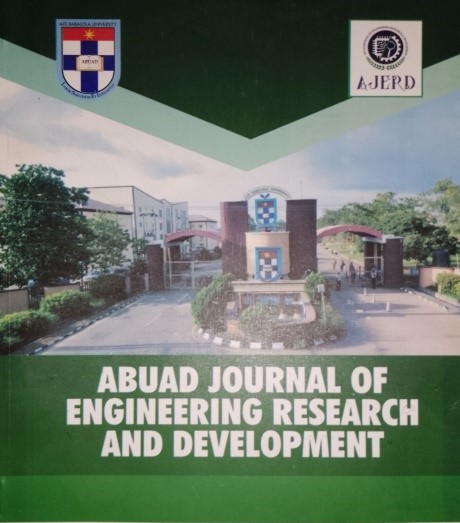Investigation of Relationship between the Surface Roughness and Residual Stress on Pearlitic Ductile Iron Face Machined
Main Article Content
Abstract
This study investigates the relationship between surface roughness and residual stress in face-milled pearlitic ductile iron in order to enhance the surface quality of machined parts used in manufacturing. Locally prepared pearlitic ductile iron was utilized. The cutting factors that were explicitly taken into consideration in this study were cutting speed, depth of cut, fluid flow rate and feed rate. Taguchi's design served as the foundation for the experiment, which used an orthogonal array with five levels for each factor. The experimental data were statistically analyzed using correlation and multiple regression analyses. The findings show a substantial positive relationship (R = 0.938, p ≤ 0.01) between surface roughness and surface residual stress, which is statistically significant. The depth of cut and feed rate increased the surface residual stress by 511.212 and 0.668 units respectively, while a unit increase in cutting speed and fluid flow rate (-0.100 and -453.350 units respectively) decreased it. Likewise, the surface roughness increased by 53.958 and 0.063 units, respectively, with an increase in the depth of cut and feed rate. However, a unit increase in cutting speed and fluid flow rate resulted in a reduction in surface roughness (-0.003 and -21.132 units, respectively). It can be deduced from the multiple regression analysis that surface residual stress and surface roughness are associated with all cutting factors. These results can be used as a guide to improve the surface integrity of machined items. Thus, the study provided important information on the best cutting parameters for producing a significantly good surface finish during face milling operations in manufacturing industries.
Downloads
Article Details

This work is licensed under a Creative Commons Attribution-NonCommercial-ShareAlike 4.0 International License.
References
Abiodun, M. O., Ilori, O. O. & Adeleke, K. M. (2018). Effect of Maize-Starch Based Cutting Fluids and Machining Parameters on Temperature Generated in Turning of AISI 304 Stainless Steel. International Journal of Multidisciplinary Sciences and Engineering, 9 (6): 18–23.
Asfour, S., Chakraborty, P., Cho, S., Onar, A. & Lynn, M. (2007). Modeling tool wear progression by using mixed effects modeling technique when end-milling AISI 4340 steel. Journal of materials processing technology. 205, 190 - 202.
Ezugwu, E. O., Richetti, A., Machado, A. R., Da Silva, M. B. & Bonney, J. (2004). Influence of the number of inserts for tool life evaluation in face milling of steels. International Journal of Machine Tools & Manufacture 44, 695–700.
Diniz, A. E. & Filho, J. C. (1999). Influence of the relative positions of tool and workpiece on tool life, tool wear and surface finish in the face milling process. Wear 232, 67 - 75.
Ilori, O. O., Adetan, D. A. & Umoru, L. E. (2017). Effect of Cutting Parameters on the Surface Residual Stress of Face-Milled Pearlitic Ductile Iron. International Journal of Materials Forming and Machining Processes, 4 (1): 38-52.
Ilori, O. O., Adetan, D. A. & Umoru, L. E. (2016). Effect of Cutting Parameters on the Surface Roughness Generated during Face Milling Operation of Pearlitic Ductile Iron with Cemented Carbide Tool. Acta Technica Corviniensis-Bulletin of Engineering Tome IX, 4: 137-144.
Karl, B. R. (2006). Metal Casting. Dept. of Materials Science and Engineering, Michigan Tech. University, USA.
Degarmo, E. P., Black, J. T. & Kohser, R. A. (2003). Materials and Processes in Manufacturing (9th Edition), Wiley.
Ductile Iron Society. (2014). Ductile Iron Data for Design Engineers. Retrieved from www.ductile.org/didata/section3/3part1.htm.
Wyatt, J. E. & Berry, J. T. (2006). A new technique for the determination of superficial residual stresses associated with machining and other manufacturing processes. Journal of Materials Processing Technology: 171, 132–140.
Hayajneh, M. T., Tahat, M. S. & Bluhm, J. (2007). A Study of the Effects of Machining Parameters on the Surface Roughness in the End-Milling Process. Jordan Journal of Mechanical and Industrial Engineering, 1(1), 1 – 5.
Arunachalam, R. M., Mannan, M. A. & Spowage, A. C. (2004). Residual stress and surface roughness when facing age hardened Inconel 718 with CBN and ceramic cutting tools. International Journal of Machine Tools & Manufacture. 44, 879–887.
M'Saoubi, R., Outeiro, J. C., Changeux, B., Lebruna, J. L. & Morao, D. A. (1999). Residual stress analysis in orthogonal machining of standard and resulfurized AISI 316L steels. Journal of Materials Processing Technology 96, 225 – 233
Ilori, O. O. , Oyewusi T. F., Fadare O. A. & Adeyemi F. F. (2024). Characterization and Impact of Cutting Parameters on Face-Milled Surfaces of Pearlitic Ductile Iron. Nigerian Journal of Technological Development, 21(2), 32-41.
Davim, J. P. (2003). Design of optimization of cutting parameters for turning metal matrix composites based on the orthogonal arrays. Journal of Materials Processing Technology, 132, 340 – 344.
llori, O. O., Adeleke, K. M., Abiodun, M. O. & Idowu, I. A. (2018). Maize-Starch Based Cutting Fluids and Process Parameters Influence on Cutting Force in Turning of AISI 304 Stainless Steel. Journal of Nigeria Institute of Mechanical Engineering, 8 (2), 102-110.




